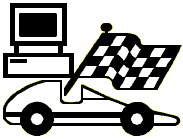|
|
How do you make fast cars?
Many of our customers have passed on the following ideas. Here they are for you.
- Reduce Air Drag
- Thinner cars run faster.
- Placement of the Weight
- Put it in the back of the car, but not so far back that the front end is
unstable. The best way to do this is to turn the car around (design it
to run backwards). The axle spacing in the kit is not symmetric. By running
the car backwards you'll be able to put the weight further back, keeping
the weight on the hill longer thus pushing the car further and faster.
- Center guide problems
- Almost everybody has enough clearance on the flat part of the track. The
problem occurs where the track has the tightest radius, which is usually
at the bottom of the sloped part of the track. Bevel the front and back
bumpers just enough so they don't rub anywhere on the track.
- Reduce Wheel Drag
-
Three wheels have less drag than four.
Before you start to carve the car, fill in the axle slots provided
in the kit with epoxy. Put the car on its side in a vertical drill press
with the top against the fence. Drill perfectly aligned axle holes (slightly
undersized) for the two rear wheels and ONE front wheel. Put a thin (.02-.04)
shim between the top of the car and the fence. Drill the second front wheel.
When the car is assembled, it will run straight and true (less drag from
side to side) on three wheels with the fourth serving only to keep the
car in the lane but with much less drag since it isn't rubbing on the track.
-
Minimize the wheel/axle contact area.
(For those who have access to the tools) Each end of the wheel hub
rubs against something, the outer edge against the nail, and the inner
edge against the car body. If the hub is slightly hollowed out (concave)
there will be less surface area rubbing and less friction. The hollow will
also serve as a graphite well.
-
Minimize the wheel/track contact area.
A usual recommendation is to buff the wheel smooth. A better recommendation
is to buff the wheel to enhance its running on a thin edge. This will reduce
the drag if the wheel is at all out of perfect alignment.
-
Make the wheel lubricate itself.
(for those who have endless supplies of money) Using right-handed and
left-handed taps of the appropriate size, tap the axle hole in each wheel
from both sides (one side with the LH tap, one side with the RH tap) 2/3rds
of the way through so that when the wheel is rolling forward the graphite
flows toward the middle. This not only keeps the graphite in place, but
changes the contact friction between the wheel hub and the axle from a
sleeve bearing to an edge bearing.
- Reduce Axle Drag
- Put each axle part way into a hand drill. Polish the head and area where
the wheel hub rubs with toothbrush and toothpaste. (And, yes, you should
have the drill spinning!)
- The Slingshot - Absolutely illegal, but a lot of fun!
- Place a small finishing nail in the lower rear center of the car (like
an exhaust pipe). On the way to the starting line, secretly place a rubber
band over the nail, stretch it under the car, and out the front. Place
the rubber band over the starting dowel as you put the car down on the
track. Be sure the starting gate goes down quickly (otherwise the car will
launch straight up) and watch the fun. Great for parent's open racing or
for an exhibition race between the Cub Master, Council Member and perhaps
Rector of the church that sponsors the Pack. (Be sure the Rector gets the
illegal car.) P.S. the rubber band will end up on the floor under the track!
One of our guiding philosophies is "Educate and Innovate, Don't Legislate!"
Put simply, this means if someone comes up with an idea how to make their
car faster, let everyone know about it. This levels the playing field.
If you make a rule banning the new innovation, you will have to worry about
people trying to get around the rules. See the link at the top of this page, 'Free Book - How to run the Pinewood Derby.'
|

![[SuperTrack]](/track/pinewood_derby_track_tr1c.jpg)
![[SuperTimer II]](/ssi/pinewood_derby_timer_pw.gif)
![[College]](/ssi/college.gif)
![[home]](/ssi/pinewood_derby_home.gif)